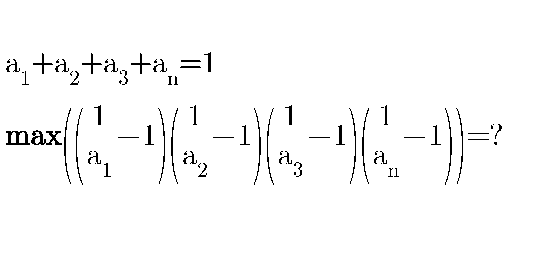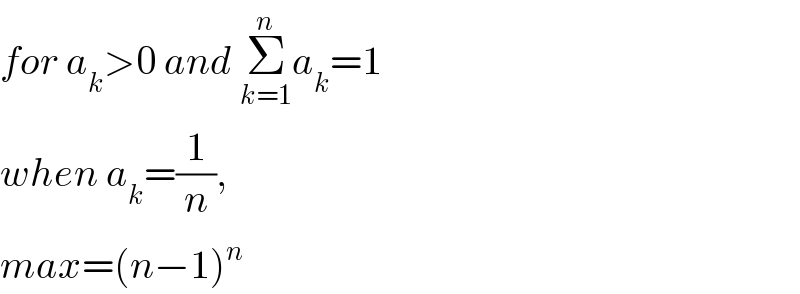
Question Number 74109 by FCB last updated on 19/Nov/19

Commented by mr W last updated on 19/Nov/19

$${for}\:{a}_{{k}} >\mathrm{0}\:{and}\:\underset{{k}=\mathrm{1}} {\overset{{n}} {\sum}}{a}_{{k}} =\mathrm{1} \\ $$$${when}\:{a}_{{k}} =\frac{\mathrm{1}}{{n}}, \\ $$$${max}=\left({n}−\mathrm{1}\right)^{{n}} \\ $$
Commented by MJS last updated on 20/Nov/19
![((1/a_n )−1)Π_(k=1) ^(n−1) ((1/a_k )−1)≈ [let a_n very close to 0 and a_1 =a_2 =...=a_(n−1) ] ≈((1/a_n )−1)((1/(1/(n−1)))−1)^(n−1) =((1/a_n )−1)(n−2)^(n−1) n>2: a_n →0^+ ⇒ ((1/a_n )−1) → +∞ the same Sir Aifour found before](Q74194.png)
$$\left(\frac{\mathrm{1}}{{a}_{{n}} }−\mathrm{1}\right)\underset{{k}=\mathrm{1}} {\overset{{n}−\mathrm{1}} {\prod}}\left(\frac{\mathrm{1}}{{a}_{{k}} }−\mathrm{1}\right)\approx \\ $$$$\:\:\:\:\:\left[\mathrm{let}\:{a}_{{n}} \:\mathrm{very}\:\mathrm{close}\:\mathrm{to}\:\mathrm{0}\:\mathrm{and}\:{a}_{\mathrm{1}} ={a}_{\mathrm{2}} =...={a}_{{n}−\mathrm{1}} \right] \\ $$$$\approx\left(\frac{\mathrm{1}}{{a}_{{n}} }−\mathrm{1}\right)\left(\frac{\mathrm{1}}{\frac{\mathrm{1}}{{n}−\mathrm{1}}}−\mathrm{1}\right)^{{n}−\mathrm{1}} =\left(\frac{\mathrm{1}}{{a}_{{n}} }−\mathrm{1}\right)\left({n}−\mathrm{2}\right)^{{n}−\mathrm{1}} \\ $$$${n}>\mathrm{2}: \\ $$$${a}_{{n}} \rightarrow\mathrm{0}^{+} \:\Rightarrow\:\left(\frac{\mathrm{1}}{{a}_{{n}} }−\mathrm{1}\right)\:\rightarrow\:+\infty \\ $$$$ \\ $$$$\mathrm{the}\:\mathrm{same}\:\mathrm{Sir}\:\mathrm{Aifour}\:\mathrm{found}\:\mathrm{before} \\ $$
Commented by FCB last updated on 20/Nov/19

$$\mathrm{thanks} \\ $$
Answered by ajfour last updated on 19/Nov/19

$${a}_{\mathrm{1}} \rightarrow\mathrm{0}\:,\:\:{a}_{\mathrm{2}} ,\:{a}_{\mathrm{3}} ,...,{a}_{{n}} \rightarrow\:\frac{\mathrm{1}}{{n}−\mathrm{1}}\: \\ $$$$\Rightarrow\:\left(\rightarrow\infty\right)×\left({n}−\mathrm{2}\right)^{{n}−\mathrm{1}} \:\rightarrow\infty\:. \\ $$
Commented by FCB last updated on 19/Nov/19

$$\mathrm{prove}\:\mathrm{that}\:\mathrm{sir} \\ $$
Commented by ajfour last updated on 19/Nov/19

$${n}\:{should}\:{be}\:{finite}>\mathrm{2}\:\:{and}\:{a}_{\mathrm{1}} \rightarrow\mathrm{0} \\ $$$${can}\:{be}\:{possible}\:{as}\:{well}! \\ $$
